Organisational Behaviour Report: 1Spatial Case Study Analysis
VerifiedAdded on 2020/11/12
|19
|5025
|199
Report
AI Summary
This report analyzes the organizational behaviour of 1Spatial, a computer software company. It examines the influence of culture, power, and politics, including Handy's organizational culture theory, Hofstede’s theory, and French & Raven's power dynamics. The report also explores content and process theories of motivation, specifically Maslow's Hierarchy of Needs and Herzberg's Two-Factor Theory, to understand employee motivation. Furthermore, it contrasts effective and ineffective teams and discusses concepts and philosophies of organizational behaviour, including Chanlat's theory of political behaviour and politicking. The analysis highlights the importance of understanding employee behaviour, creating a positive work culture, and using motivation techniques to achieve organizational goals.
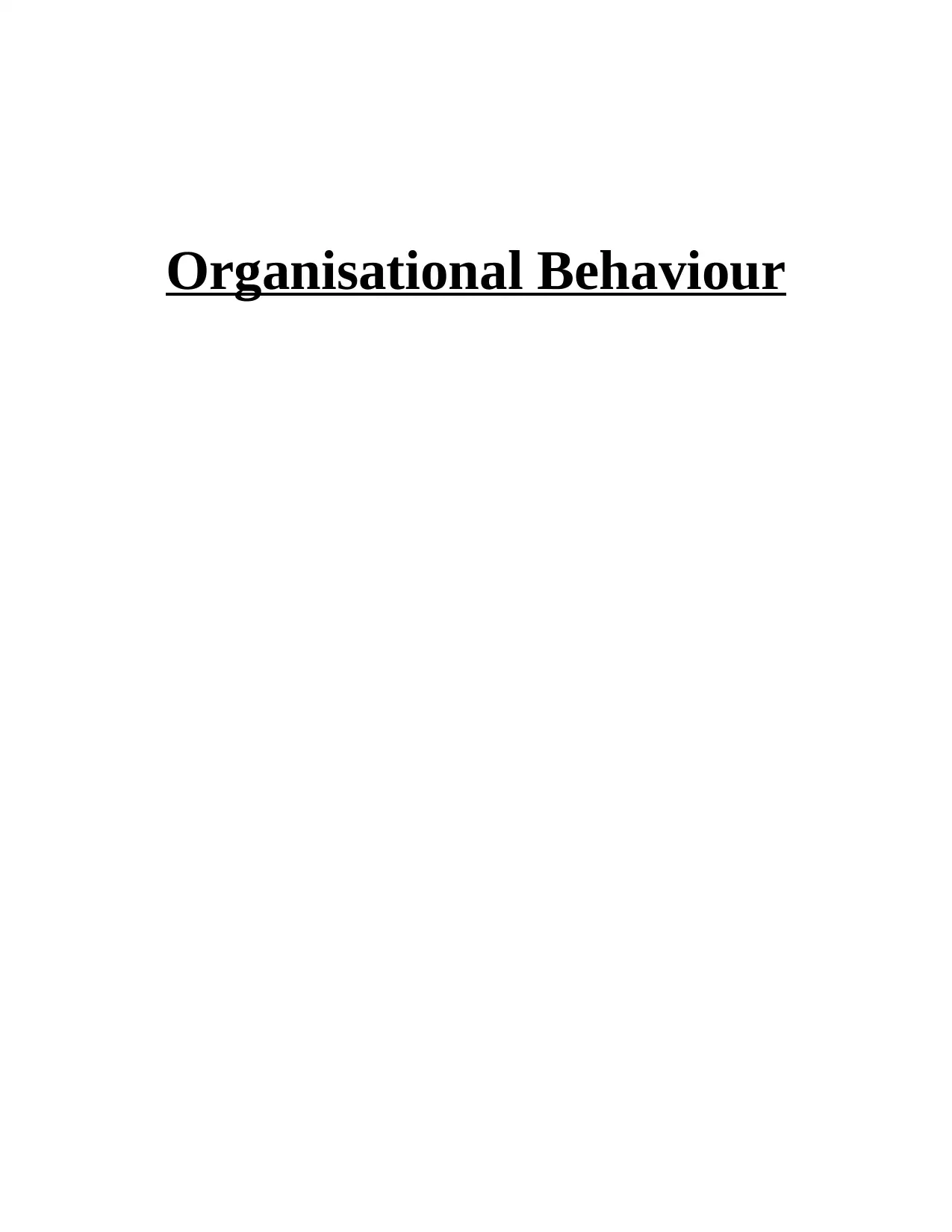
Organisational Behaviour
Paraphrase This Document
Need a fresh take? Get an instant paraphrase of this document with our AI Paraphraser
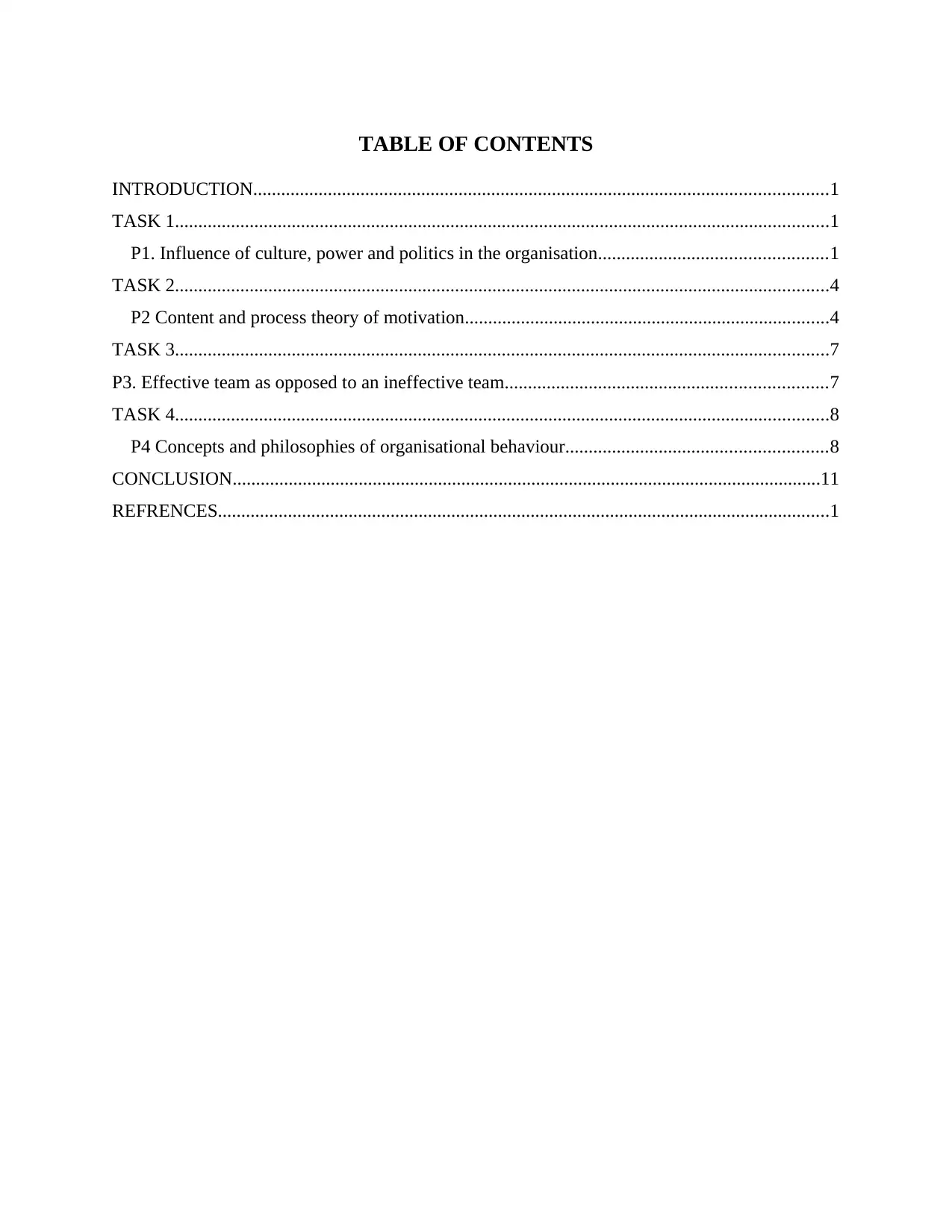
TABLE OF CONTENTS
INTRODUCTION...........................................................................................................................1
TASK 1............................................................................................................................................1
P1. Influence of culture, power and politics in the organisation.................................................1
TASK 2............................................................................................................................................4
P2 Content and process theory of motivation..............................................................................4
TASK 3............................................................................................................................................7
P3. Effective team as opposed to an ineffective team.....................................................................7
TASK 4............................................................................................................................................8
P4 Concepts and philosophies of organisational behaviour........................................................8
CONCLUSION..............................................................................................................................11
REFRENCES...................................................................................................................................1
INTRODUCTION...........................................................................................................................1
TASK 1............................................................................................................................................1
P1. Influence of culture, power and politics in the organisation.................................................1
TASK 2............................................................................................................................................4
P2 Content and process theory of motivation..............................................................................4
TASK 3............................................................................................................................................7
P3. Effective team as opposed to an ineffective team.....................................................................7
TASK 4............................................................................................................................................8
P4 Concepts and philosophies of organisational behaviour........................................................8
CONCLUSION..............................................................................................................................11
REFRENCES...................................................................................................................................1

⊘ This is a preview!⊘
Do you want full access?
Subscribe today to unlock all pages.

Trusted by 1+ million students worldwide
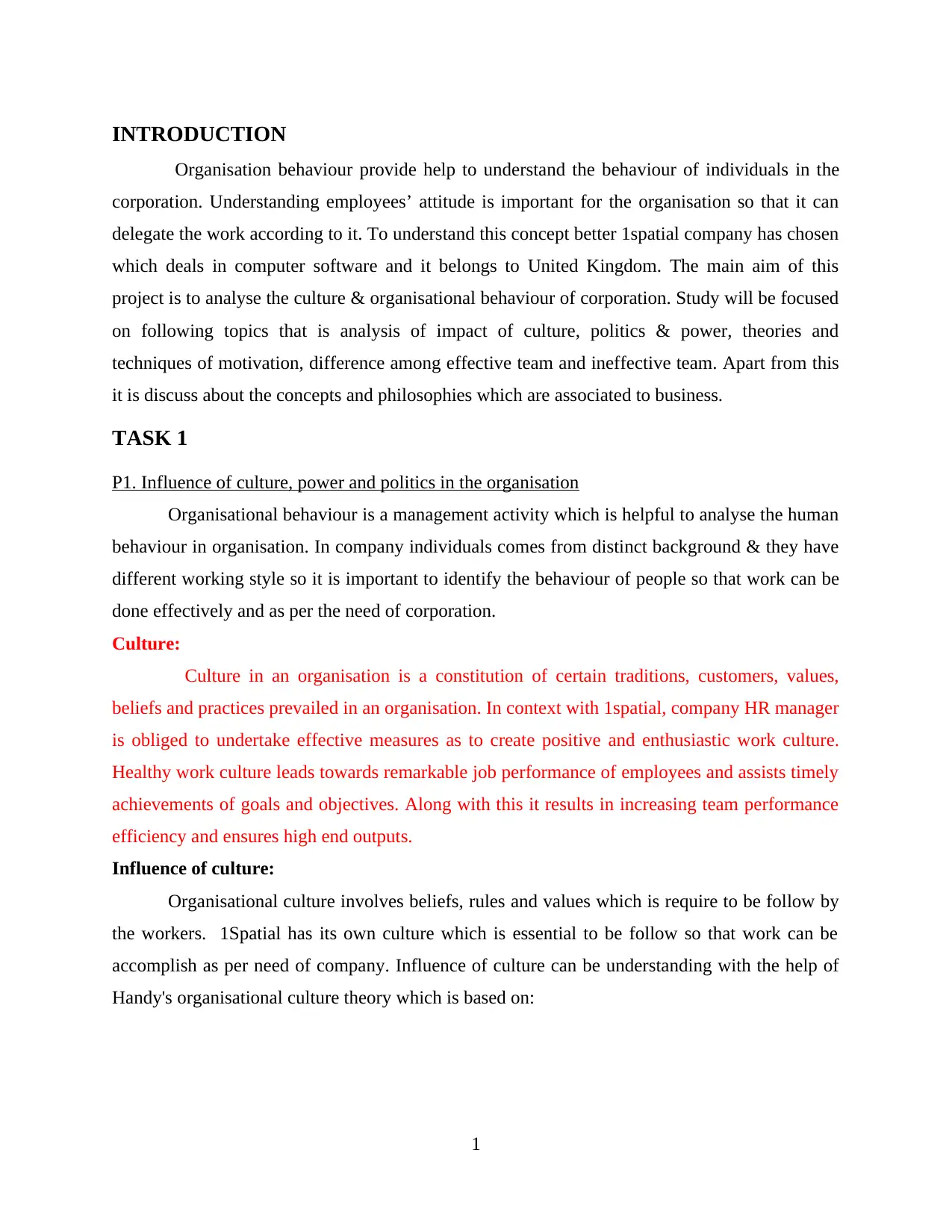
INTRODUCTION
Organisation behaviour provide help to understand the behaviour of individuals in the
corporation. Understanding employees’ attitude is important for the organisation so that it can
delegate the work according to it. To understand this concept better 1spatial company has chosen
which deals in computer software and it belongs to United Kingdom. The main aim of this
project is to analyse the culture & organisational behaviour of corporation. Study will be focused
on following topics that is analysis of impact of culture, politics & power, theories and
techniques of motivation, difference among effective team and ineffective team. Apart from this
it is discuss about the concepts and philosophies which are associated to business.
TASK 1
P1. Influence of culture, power and politics in the organisation
Organisational behaviour is a management activity which is helpful to analyse the human
behaviour in organisation. In company individuals comes from distinct background & they have
different working style so it is important to identify the behaviour of people so that work can be
done effectively and as per the need of corporation.
Culture:
Culture in an organisation is a constitution of certain traditions, customers, values,
beliefs and practices prevailed in an organisation. In context with 1spatial, company HR manager
is obliged to undertake effective measures as to create positive and enthusiastic work culture.
Healthy work culture leads towards remarkable job performance of employees and assists timely
achievements of goals and objectives. Along with this it results in increasing team performance
efficiency and ensures high end outputs.
Influence of culture:
Organisational culture involves beliefs, rules and values which is require to be follow by
the workers. 1Spatial has its own culture which is essential to be follow so that work can be
accomplish as per need of company. Influence of culture can be understanding with the help of
Handy's organisational culture theory which is based on:
1
Organisation behaviour provide help to understand the behaviour of individuals in the
corporation. Understanding employees’ attitude is important for the organisation so that it can
delegate the work according to it. To understand this concept better 1spatial company has chosen
which deals in computer software and it belongs to United Kingdom. The main aim of this
project is to analyse the culture & organisational behaviour of corporation. Study will be focused
on following topics that is analysis of impact of culture, politics & power, theories and
techniques of motivation, difference among effective team and ineffective team. Apart from this
it is discuss about the concepts and philosophies which are associated to business.
TASK 1
P1. Influence of culture, power and politics in the organisation
Organisational behaviour is a management activity which is helpful to analyse the human
behaviour in organisation. In company individuals comes from distinct background & they have
different working style so it is important to identify the behaviour of people so that work can be
done effectively and as per the need of corporation.
Culture:
Culture in an organisation is a constitution of certain traditions, customers, values,
beliefs and practices prevailed in an organisation. In context with 1spatial, company HR manager
is obliged to undertake effective measures as to create positive and enthusiastic work culture.
Healthy work culture leads towards remarkable job performance of employees and assists timely
achievements of goals and objectives. Along with this it results in increasing team performance
efficiency and ensures high end outputs.
Influence of culture:
Organisational culture involves beliefs, rules and values which is require to be follow by
the workers. 1Spatial has its own culture which is essential to be follow so that work can be
accomplish as per need of company. Influence of culture can be understanding with the help of
Handy's organisational culture theory which is based on:
1
Paraphrase This Document
Need a fresh take? Get an instant paraphrase of this document with our AI Paraphraser
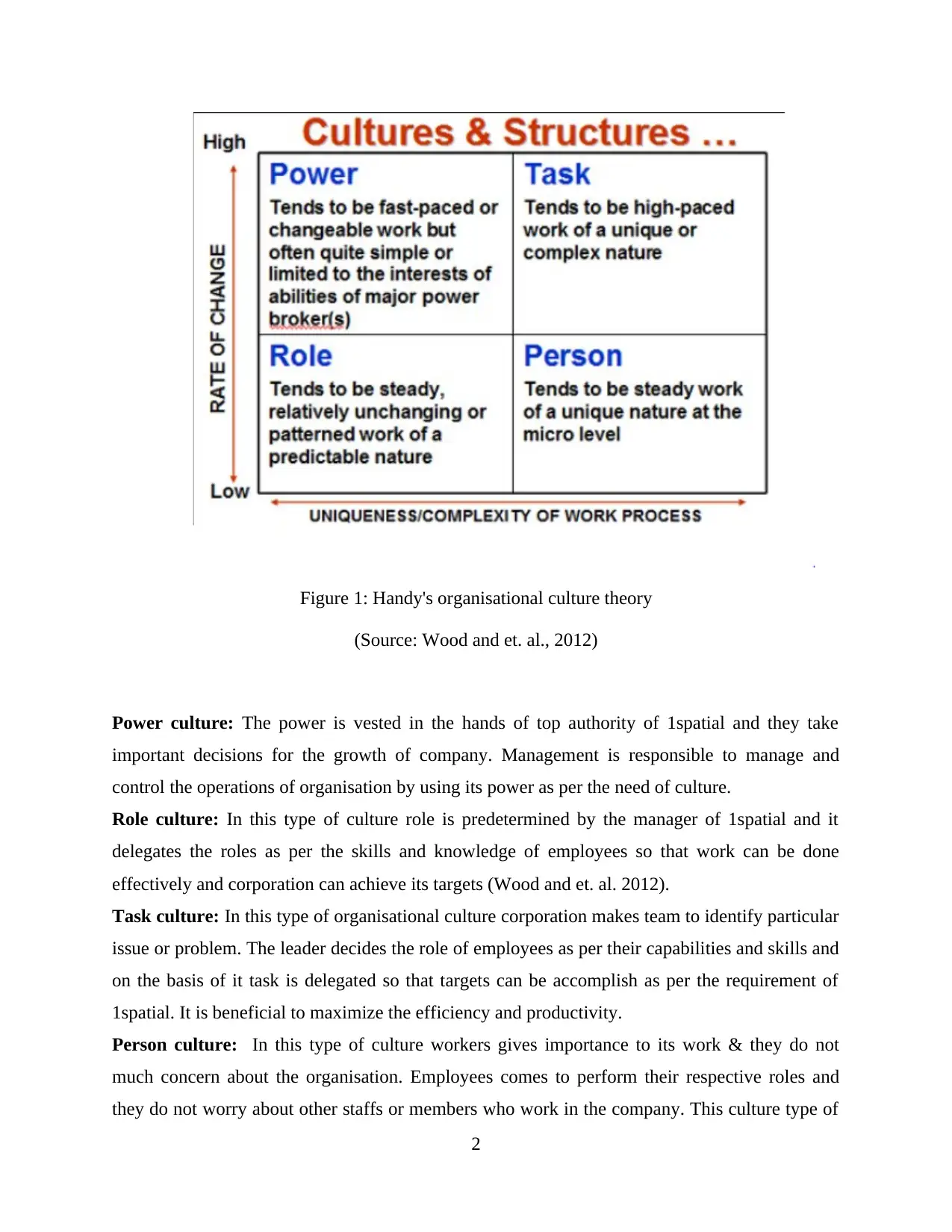
Figure 1: Handy's organisational culture theory
(Source: Wood and et. al., 2012)
Power culture: The power is vested in the hands of top authority of 1spatial and they take
important decisions for the growth of company. Management is responsible to manage and
control the operations of organisation by using its power as per the need of culture.
Role culture: In this type of culture role is predetermined by the manager of 1spatial and it
delegates the roles as per the skills and knowledge of employees so that work can be done
effectively and corporation can achieve its targets (Wood and et. al. 2012).
Task culture: In this type of organisational culture corporation makes team to identify particular
issue or problem. The leader decides the role of employees as per their capabilities and skills and
on the basis of it task is delegated so that targets can be accomplish as per the requirement of
1spatial. It is beneficial to maximize the efficiency and productivity.
Person culture: In this type of culture workers gives importance to its work & they do not
much concern about the organisation. Employees comes to perform their respective roles and
they do not worry about other staffs or members who work in the company. This culture type of
2
(Source: Wood and et. al., 2012)
Power culture: The power is vested in the hands of top authority of 1spatial and they take
important decisions for the growth of company. Management is responsible to manage and
control the operations of organisation by using its power as per the need of culture.
Role culture: In this type of culture role is predetermined by the manager of 1spatial and it
delegates the roles as per the skills and knowledge of employees so that work can be done
effectively and corporation can achieve its targets (Wood and et. al. 2012).
Task culture: In this type of organisational culture corporation makes team to identify particular
issue or problem. The leader decides the role of employees as per their capabilities and skills and
on the basis of it task is delegated so that targets can be accomplish as per the requirement of
1spatial. It is beneficial to maximize the efficiency and productivity.
Person culture: In this type of culture workers gives importance to its work & they do not
much concern about the organisation. Employees comes to perform their respective roles and
they do not worry about other staffs or members who work in the company. This culture type of
2
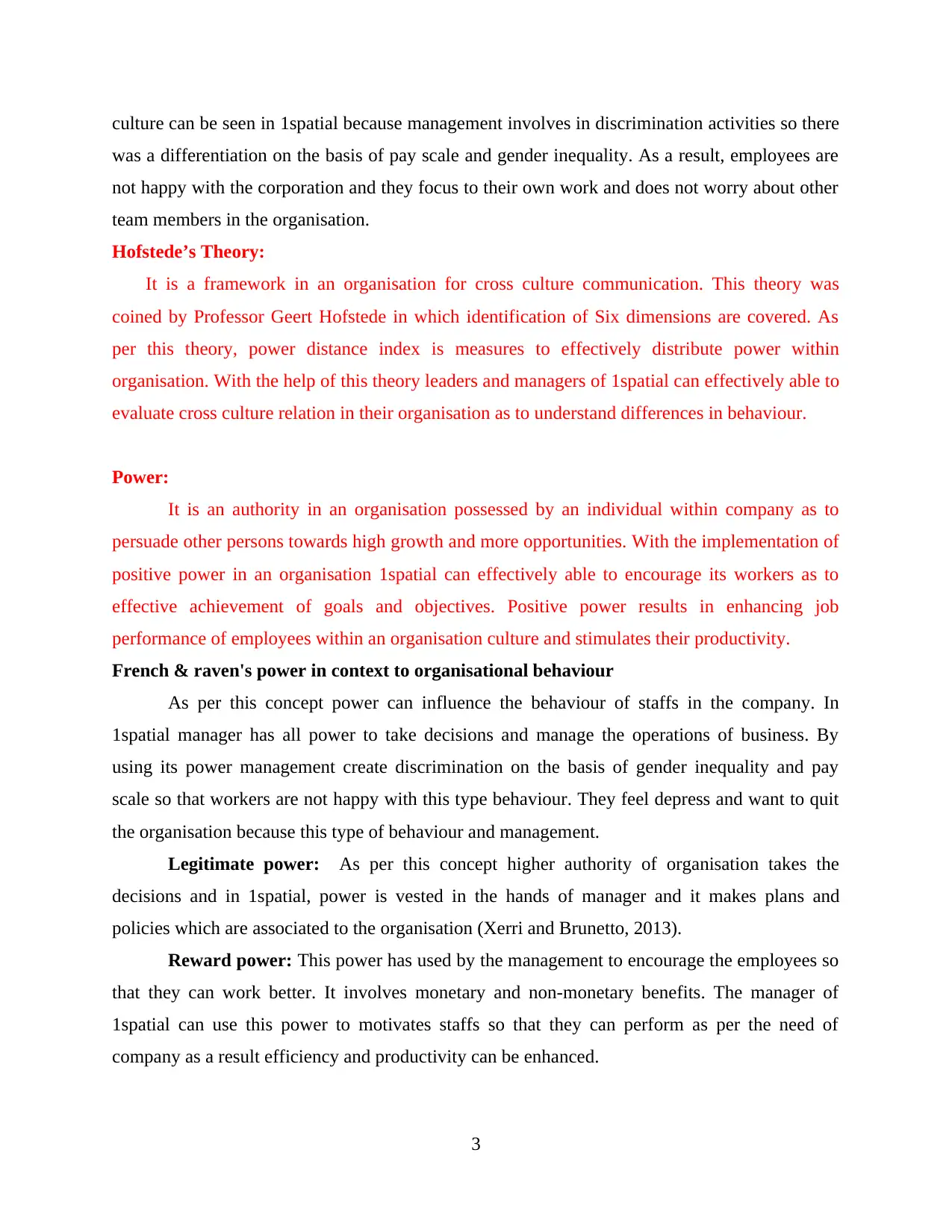
culture can be seen in 1spatial because management involves in discrimination activities so there
was a differentiation on the basis of pay scale and gender inequality. As a result, employees are
not happy with the corporation and they focus to their own work and does not worry about other
team members in the organisation.
Hofstede’s Theory:
It is a framework in an organisation for cross culture communication. This theory was
coined by Professor Geert Hofstede in which identification of Six dimensions are covered. As
per this theory, power distance index is measures to effectively distribute power within
organisation. With the help of this theory leaders and managers of 1spatial can effectively able to
evaluate cross culture relation in their organisation as to understand differences in behaviour.
Power:
It is an authority in an organisation possessed by an individual within company as to
persuade other persons towards high growth and more opportunities. With the implementation of
positive power in an organisation 1spatial can effectively able to encourage its workers as to
effective achievement of goals and objectives. Positive power results in enhancing job
performance of employees within an organisation culture and stimulates their productivity.
French & raven's power in context to organisational behaviour
As per this concept power can influence the behaviour of staffs in the company. In
1spatial manager has all power to take decisions and manage the operations of business. By
using its power management create discrimination on the basis of gender inequality and pay
scale so that workers are not happy with this type behaviour. They feel depress and want to quit
the organisation because this type of behaviour and management.
Legitimate power: As per this concept higher authority of organisation takes the
decisions and in 1spatial, power is vested in the hands of manager and it makes plans and
policies which are associated to the organisation (Xerri and Brunetto, 2013).
Reward power: This power has used by the management to encourage the employees so
that they can work better. It involves monetary and non-monetary benefits. The manager of
1spatial can use this power to motivates staffs so that they can perform as per the need of
company as a result efficiency and productivity can be enhanced.
3
was a differentiation on the basis of pay scale and gender inequality. As a result, employees are
not happy with the corporation and they focus to their own work and does not worry about other
team members in the organisation.
Hofstede’s Theory:
It is a framework in an organisation for cross culture communication. This theory was
coined by Professor Geert Hofstede in which identification of Six dimensions are covered. As
per this theory, power distance index is measures to effectively distribute power within
organisation. With the help of this theory leaders and managers of 1spatial can effectively able to
evaluate cross culture relation in their organisation as to understand differences in behaviour.
Power:
It is an authority in an organisation possessed by an individual within company as to
persuade other persons towards high growth and more opportunities. With the implementation of
positive power in an organisation 1spatial can effectively able to encourage its workers as to
effective achievement of goals and objectives. Positive power results in enhancing job
performance of employees within an organisation culture and stimulates their productivity.
French & raven's power in context to organisational behaviour
As per this concept power can influence the behaviour of staffs in the company. In
1spatial manager has all power to take decisions and manage the operations of business. By
using its power management create discrimination on the basis of gender inequality and pay
scale so that workers are not happy with this type behaviour. They feel depress and want to quit
the organisation because this type of behaviour and management.
Legitimate power: As per this concept higher authority of organisation takes the
decisions and in 1spatial, power is vested in the hands of manager and it makes plans and
policies which are associated to the organisation (Xerri and Brunetto, 2013).
Reward power: This power has used by the management to encourage the employees so
that they can work better. It involves monetary and non-monetary benefits. The manager of
1spatial can use this power to motivates staffs so that they can perform as per the need of
company as a result efficiency and productivity can be enhanced.
3
⊘ This is a preview!⊘
Do you want full access?
Subscribe today to unlock all pages.

Trusted by 1+ million students worldwide
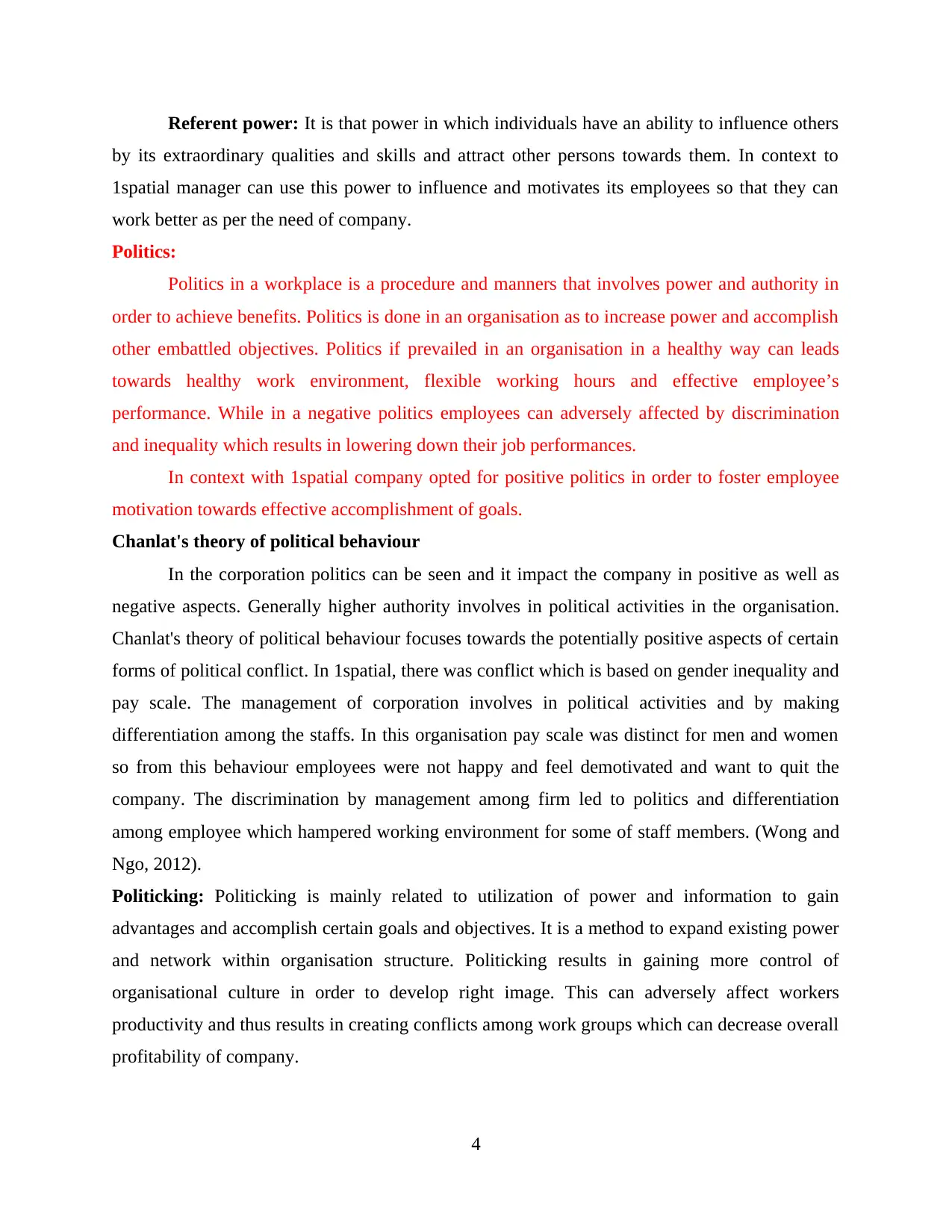
Referent power: It is that power in which individuals have an ability to influence others
by its extraordinary qualities and skills and attract other persons towards them. In context to
1spatial manager can use this power to influence and motivates its employees so that they can
work better as per the need of company.
Politics:
Politics in a workplace is a procedure and manners that involves power and authority in
order to achieve benefits. Politics is done in an organisation as to increase power and accomplish
other embattled objectives. Politics if prevailed in an organisation in a healthy way can leads
towards healthy work environment, flexible working hours and effective employee’s
performance. While in a negative politics employees can adversely affected by discrimination
and inequality which results in lowering down their job performances.
In context with 1spatial company opted for positive politics in order to foster employee
motivation towards effective accomplishment of goals.
Chanlat's theory of political behaviour
In the corporation politics can be seen and it impact the company in positive as well as
negative aspects. Generally higher authority involves in political activities in the organisation.
Chanlat's theory of political behaviour focuses towards the potentially positive aspects of certain
forms of political conflict. In 1spatial, there was conflict which is based on gender inequality and
pay scale. The management of corporation involves in political activities and by making
differentiation among the staffs. In this organisation pay scale was distinct for men and women
so from this behaviour employees were not happy and feel demotivated and want to quit the
company. The discrimination by management among firm led to politics and differentiation
among employee which hampered working environment for some of staff members. (Wong and
Ngo, 2012).
Politicking: Politicking is mainly related to utilization of power and information to gain
advantages and accomplish certain goals and objectives. It is a method to expand existing power
and network within organisation structure. Politicking results in gaining more control of
organisational culture in order to develop right image. This can adversely affect workers
productivity and thus results in creating conflicts among work groups which can decrease overall
profitability of company.
4
by its extraordinary qualities and skills and attract other persons towards them. In context to
1spatial manager can use this power to influence and motivates its employees so that they can
work better as per the need of company.
Politics:
Politics in a workplace is a procedure and manners that involves power and authority in
order to achieve benefits. Politics is done in an organisation as to increase power and accomplish
other embattled objectives. Politics if prevailed in an organisation in a healthy way can leads
towards healthy work environment, flexible working hours and effective employee’s
performance. While in a negative politics employees can adversely affected by discrimination
and inequality which results in lowering down their job performances.
In context with 1spatial company opted for positive politics in order to foster employee
motivation towards effective accomplishment of goals.
Chanlat's theory of political behaviour
In the corporation politics can be seen and it impact the company in positive as well as
negative aspects. Generally higher authority involves in political activities in the organisation.
Chanlat's theory of political behaviour focuses towards the potentially positive aspects of certain
forms of political conflict. In 1spatial, there was conflict which is based on gender inequality and
pay scale. The management of corporation involves in political activities and by making
differentiation among the staffs. In this organisation pay scale was distinct for men and women
so from this behaviour employees were not happy and feel demotivated and want to quit the
company. The discrimination by management among firm led to politics and differentiation
among employee which hampered working environment for some of staff members. (Wong and
Ngo, 2012).
Politicking: Politicking is mainly related to utilization of power and information to gain
advantages and accomplish certain goals and objectives. It is a method to expand existing power
and network within organisation structure. Politicking results in gaining more control of
organisational culture in order to develop right image. This can adversely affect workers
productivity and thus results in creating conflicts among work groups which can decrease overall
profitability of company.
4
Paraphrase This Document
Need a fresh take? Get an instant paraphrase of this document with our AI Paraphraser
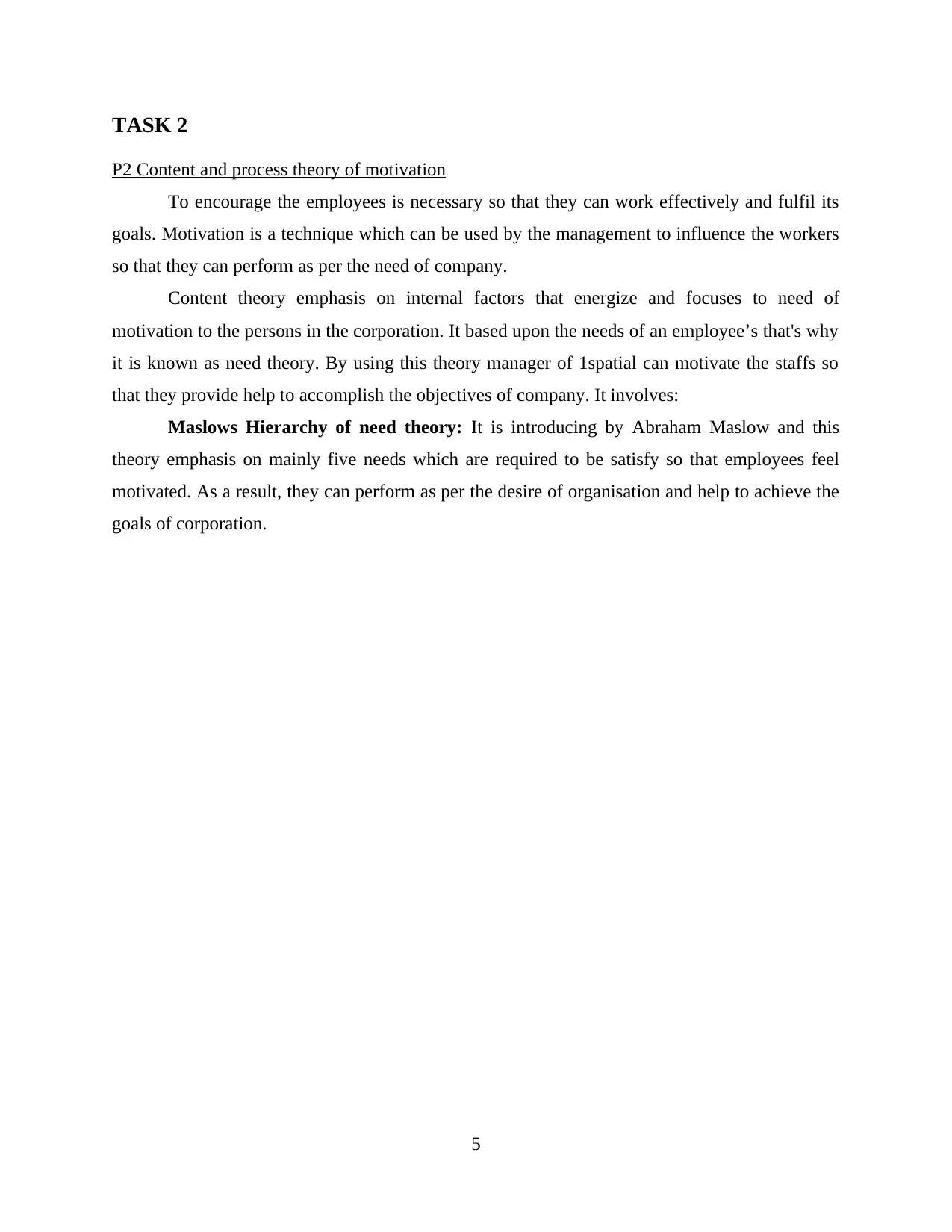
TASK 2
P2 Content and process theory of motivation
To encourage the employees is necessary so that they can work effectively and fulfil its
goals. Motivation is a technique which can be used by the management to influence the workers
so that they can perform as per the need of company.
Content theory emphasis on internal factors that energize and focuses to need of
motivation to the persons in the corporation. It based upon the needs of an employee’s that's why
it is known as need theory. By using this theory manager of 1spatial can motivate the staffs so
that they provide help to accomplish the objectives of company. It involves:
Maslows Hierarchy of need theory: It is introducing by Abraham Maslow and this
theory emphasis on mainly five needs which are required to be satisfy so that employees feel
motivated. As a result, they can perform as per the desire of organisation and help to achieve the
goals of corporation.
5
P2 Content and process theory of motivation
To encourage the employees is necessary so that they can work effectively and fulfil its
goals. Motivation is a technique which can be used by the management to influence the workers
so that they can perform as per the need of company.
Content theory emphasis on internal factors that energize and focuses to need of
motivation to the persons in the corporation. It based upon the needs of an employee’s that's why
it is known as need theory. By using this theory manager of 1spatial can motivate the staffs so
that they provide help to accomplish the objectives of company. It involves:
Maslows Hierarchy of need theory: It is introducing by Abraham Maslow and this
theory emphasis on mainly five needs which are required to be satisfy so that employees feel
motivated. As a result, they can perform as per the desire of organisation and help to achieve the
goals of corporation.
5
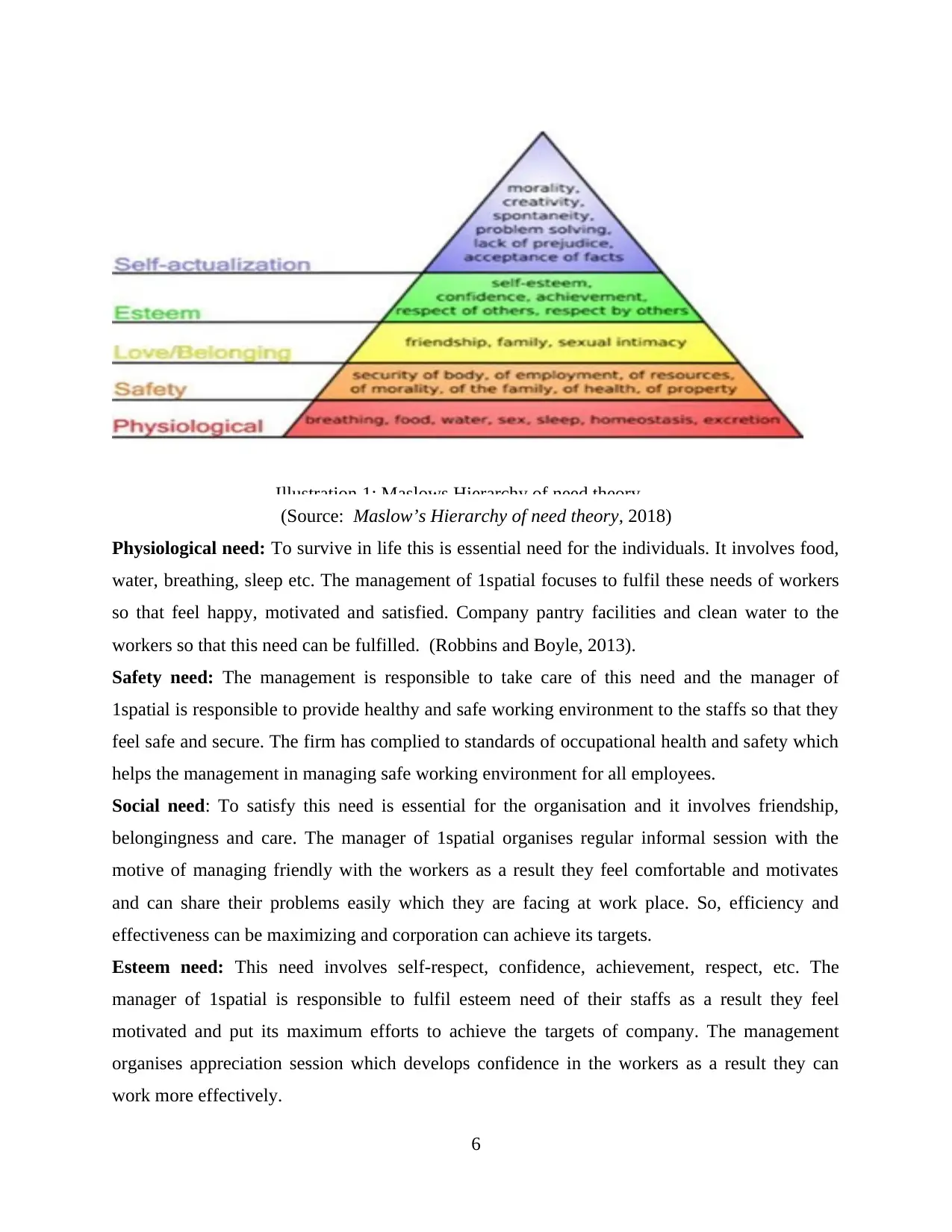
Illustration 1: Maslows Hierarchy of need theory
(Source: Maslow’s Hierarchy of need theory, 2018)
Physiological need: To survive in life this is essential need for the individuals. It involves food,
water, breathing, sleep etc. The management of 1spatial focuses to fulfil these needs of workers
so that feel happy, motivated and satisfied. Company pantry facilities and clean water to the
workers so that this need can be fulfilled. (Robbins and Boyle, 2013).
Safety need: The management is responsible to take care of this need and the manager of
1spatial is responsible to provide healthy and safe working environment to the staffs so that they
feel safe and secure. The firm has complied to standards of occupational health and safety which
helps the management in managing safe working environment for all employees.
Social need: To satisfy this need is essential for the organisation and it involves friendship,
belongingness and care. The manager of 1spatial organises regular informal session with the
motive of managing friendly with the workers as a result they feel comfortable and motivates
and can share their problems easily which they are facing at work place. So, efficiency and
effectiveness can be maximizing and corporation can achieve its targets.
Esteem need: This need involves self-respect, confidence, achievement, respect, etc. The
manager of 1spatial is responsible to fulfil esteem need of their staffs as a result they feel
motivated and put its maximum efforts to achieve the targets of company. The management
organises appreciation session which develops confidence in the workers as a result they can
work more effectively.
6
(Source: Maslow’s Hierarchy of need theory, 2018)
Physiological need: To survive in life this is essential need for the individuals. It involves food,
water, breathing, sleep etc. The management of 1spatial focuses to fulfil these needs of workers
so that feel happy, motivated and satisfied. Company pantry facilities and clean water to the
workers so that this need can be fulfilled. (Robbins and Boyle, 2013).
Safety need: The management is responsible to take care of this need and the manager of
1spatial is responsible to provide healthy and safe working environment to the staffs so that they
feel safe and secure. The firm has complied to standards of occupational health and safety which
helps the management in managing safe working environment for all employees.
Social need: To satisfy this need is essential for the organisation and it involves friendship,
belongingness and care. The manager of 1spatial organises regular informal session with the
motive of managing friendly with the workers as a result they feel comfortable and motivates
and can share their problems easily which they are facing at work place. So, efficiency and
effectiveness can be maximizing and corporation can achieve its targets.
Esteem need: This need involves self-respect, confidence, achievement, respect, etc. The
manager of 1spatial is responsible to fulfil esteem need of their staffs as a result they feel
motivated and put its maximum efforts to achieve the targets of company. The management
organises appreciation session which develops confidence in the workers as a result they can
work more effectively.
6
⊘ This is a preview!⊘
Do you want full access?
Subscribe today to unlock all pages.

Trusted by 1+ million students worldwide
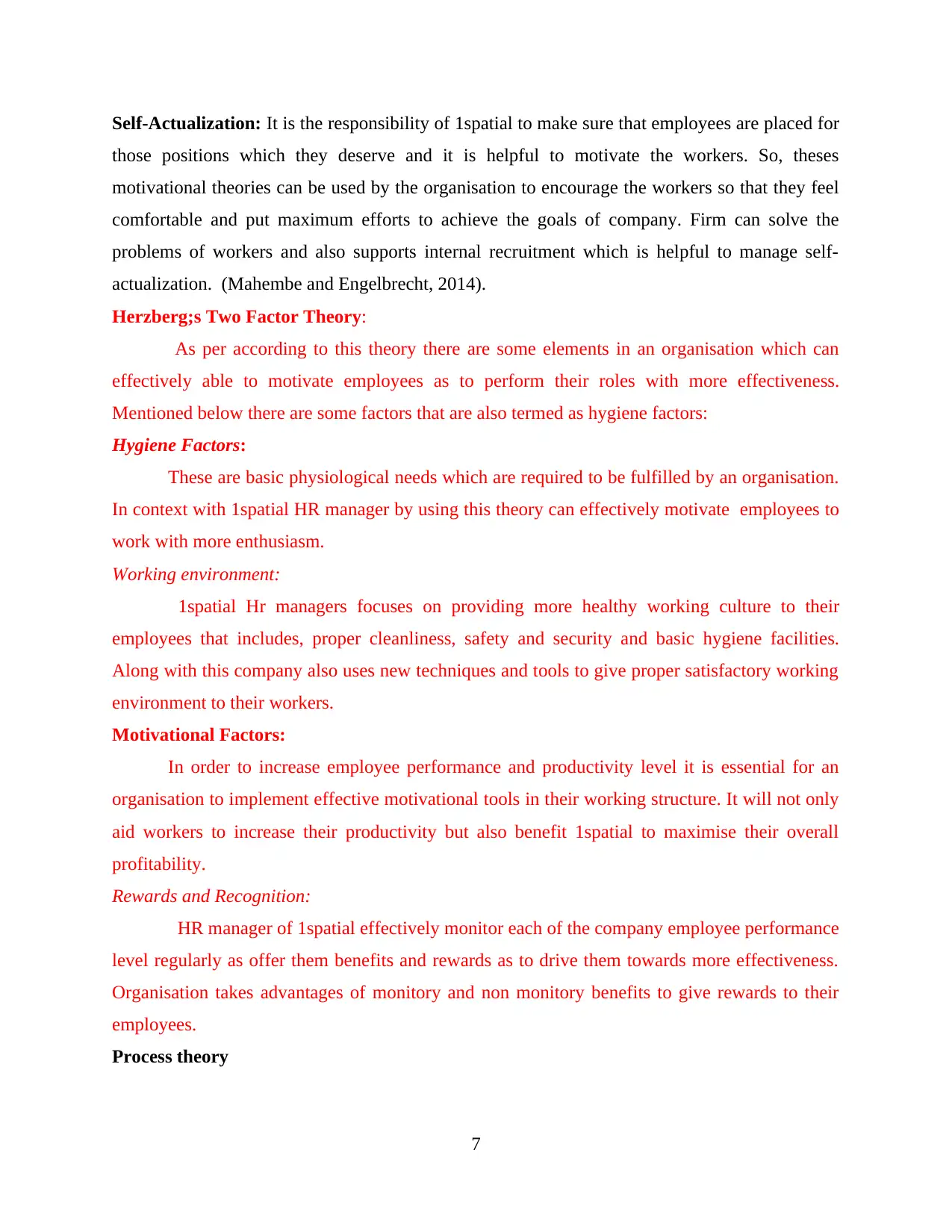
Self-Actualization: It is the responsibility of 1spatial to make sure that employees are placed for
those positions which they deserve and it is helpful to motivate the workers. So, theses
motivational theories can be used by the organisation to encourage the workers so that they feel
comfortable and put maximum efforts to achieve the goals of company. Firm can solve the
problems of workers and also supports internal recruitment which is helpful to manage self-
actualization. (Mahembe and Engelbrecht, 2014).
Herzberg;s Two Factor Theory:
As per according to this theory there are some elements in an organisation which can
effectively able to motivate employees as to perform their roles with more effectiveness.
Mentioned below there are some factors that are also termed as hygiene factors:
Hygiene Factors:
These are basic physiological needs which are required to be fulfilled by an organisation.
In context with 1spatial HR manager by using this theory can effectively motivate employees to
work with more enthusiasm.
Working environment:
1spatial Hr managers focuses on providing more healthy working culture to their
employees that includes, proper cleanliness, safety and security and basic hygiene facilities.
Along with this company also uses new techniques and tools to give proper satisfactory working
environment to their workers.
Motivational Factors:
In order to increase employee performance and productivity level it is essential for an
organisation to implement effective motivational tools in their working structure. It will not only
aid workers to increase their productivity but also benefit 1spatial to maximise their overall
profitability.
Rewards and Recognition:
HR manager of 1spatial effectively monitor each of the company employee performance
level regularly as offer them benefits and rewards as to drive them towards more effectiveness.
Organisation takes advantages of monitory and non monitory benefits to give rewards to their
employees.
Process theory
7
those positions which they deserve and it is helpful to motivate the workers. So, theses
motivational theories can be used by the organisation to encourage the workers so that they feel
comfortable and put maximum efforts to achieve the goals of company. Firm can solve the
problems of workers and also supports internal recruitment which is helpful to manage self-
actualization. (Mahembe and Engelbrecht, 2014).
Herzberg;s Two Factor Theory:
As per according to this theory there are some elements in an organisation which can
effectively able to motivate employees as to perform their roles with more effectiveness.
Mentioned below there are some factors that are also termed as hygiene factors:
Hygiene Factors:
These are basic physiological needs which are required to be fulfilled by an organisation.
In context with 1spatial HR manager by using this theory can effectively motivate employees to
work with more enthusiasm.
Working environment:
1spatial Hr managers focuses on providing more healthy working culture to their
employees that includes, proper cleanliness, safety and security and basic hygiene facilities.
Along with this company also uses new techniques and tools to give proper satisfactory working
environment to their workers.
Motivational Factors:
In order to increase employee performance and productivity level it is essential for an
organisation to implement effective motivational tools in their working structure. It will not only
aid workers to increase their productivity but also benefit 1spatial to maximise their overall
profitability.
Rewards and Recognition:
HR manager of 1spatial effectively monitor each of the company employee performance
level regularly as offer them benefits and rewards as to drive them towards more effectiveness.
Organisation takes advantages of monitory and non monitory benefits to give rewards to their
employees.
Process theory
7
Paraphrase This Document
Need a fresh take? Get an instant paraphrase of this document with our AI Paraphraser
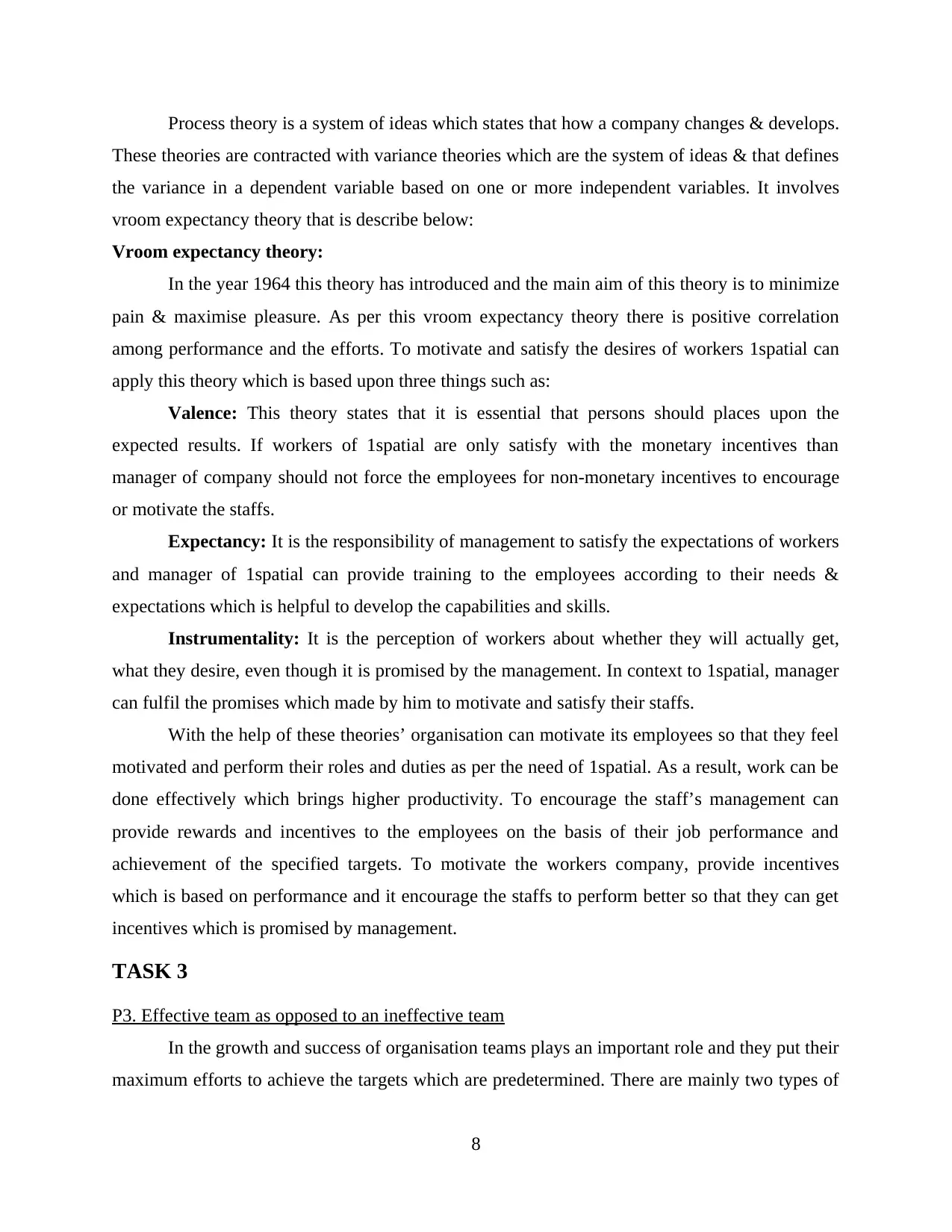
Process theory is a system of ideas which states that how a company changes & develops.
These theories are contracted with variance theories which are the system of ideas & that defines
the variance in a dependent variable based on one or more independent variables. It involves
vroom expectancy theory that is describe below:
Vroom expectancy theory:
In the year 1964 this theory has introduced and the main aim of this theory is to minimize
pain & maximise pleasure. As per this vroom expectancy theory there is positive correlation
among performance and the efforts. To motivate and satisfy the desires of workers 1spatial can
apply this theory which is based upon three things such as:
Valence: This theory states that it is essential that persons should places upon the
expected results. If workers of 1spatial are only satisfy with the monetary incentives than
manager of company should not force the employees for non-monetary incentives to encourage
or motivate the staffs.
Expectancy: It is the responsibility of management to satisfy the expectations of workers
and manager of 1spatial can provide training to the employees according to their needs &
expectations which is helpful to develop the capabilities and skills.
Instrumentality: It is the perception of workers about whether they will actually get,
what they desire, even though it is promised by the management. In context to 1spatial, manager
can fulfil the promises which made by him to motivate and satisfy their staffs.
With the help of these theories’ organisation can motivate its employees so that they feel
motivated and perform their roles and duties as per the need of 1spatial. As a result, work can be
done effectively which brings higher productivity. To encourage the staff’s management can
provide rewards and incentives to the employees on the basis of their job performance and
achievement of the specified targets. To motivate the workers company, provide incentives
which is based on performance and it encourage the staffs to perform better so that they can get
incentives which is promised by management.
TASK 3
P3. Effective team as opposed to an ineffective team
In the growth and success of organisation teams plays an important role and they put their
maximum efforts to achieve the targets which are predetermined. There are mainly two types of
8
These theories are contracted with variance theories which are the system of ideas & that defines
the variance in a dependent variable based on one or more independent variables. It involves
vroom expectancy theory that is describe below:
Vroom expectancy theory:
In the year 1964 this theory has introduced and the main aim of this theory is to minimize
pain & maximise pleasure. As per this vroom expectancy theory there is positive correlation
among performance and the efforts. To motivate and satisfy the desires of workers 1spatial can
apply this theory which is based upon three things such as:
Valence: This theory states that it is essential that persons should places upon the
expected results. If workers of 1spatial are only satisfy with the monetary incentives than
manager of company should not force the employees for non-monetary incentives to encourage
or motivate the staffs.
Expectancy: It is the responsibility of management to satisfy the expectations of workers
and manager of 1spatial can provide training to the employees according to their needs &
expectations which is helpful to develop the capabilities and skills.
Instrumentality: It is the perception of workers about whether they will actually get,
what they desire, even though it is promised by the management. In context to 1spatial, manager
can fulfil the promises which made by him to motivate and satisfy their staffs.
With the help of these theories’ organisation can motivate its employees so that they feel
motivated and perform their roles and duties as per the need of 1spatial. As a result, work can be
done effectively which brings higher productivity. To encourage the staff’s management can
provide rewards and incentives to the employees on the basis of their job performance and
achievement of the specified targets. To motivate the workers company, provide incentives
which is based on performance and it encourage the staffs to perform better so that they can get
incentives which is promised by management.
TASK 3
P3. Effective team as opposed to an ineffective team
In the growth and success of organisation teams plays an important role and they put their
maximum efforts to achieve the targets which are predetermined. There are mainly two types of
8
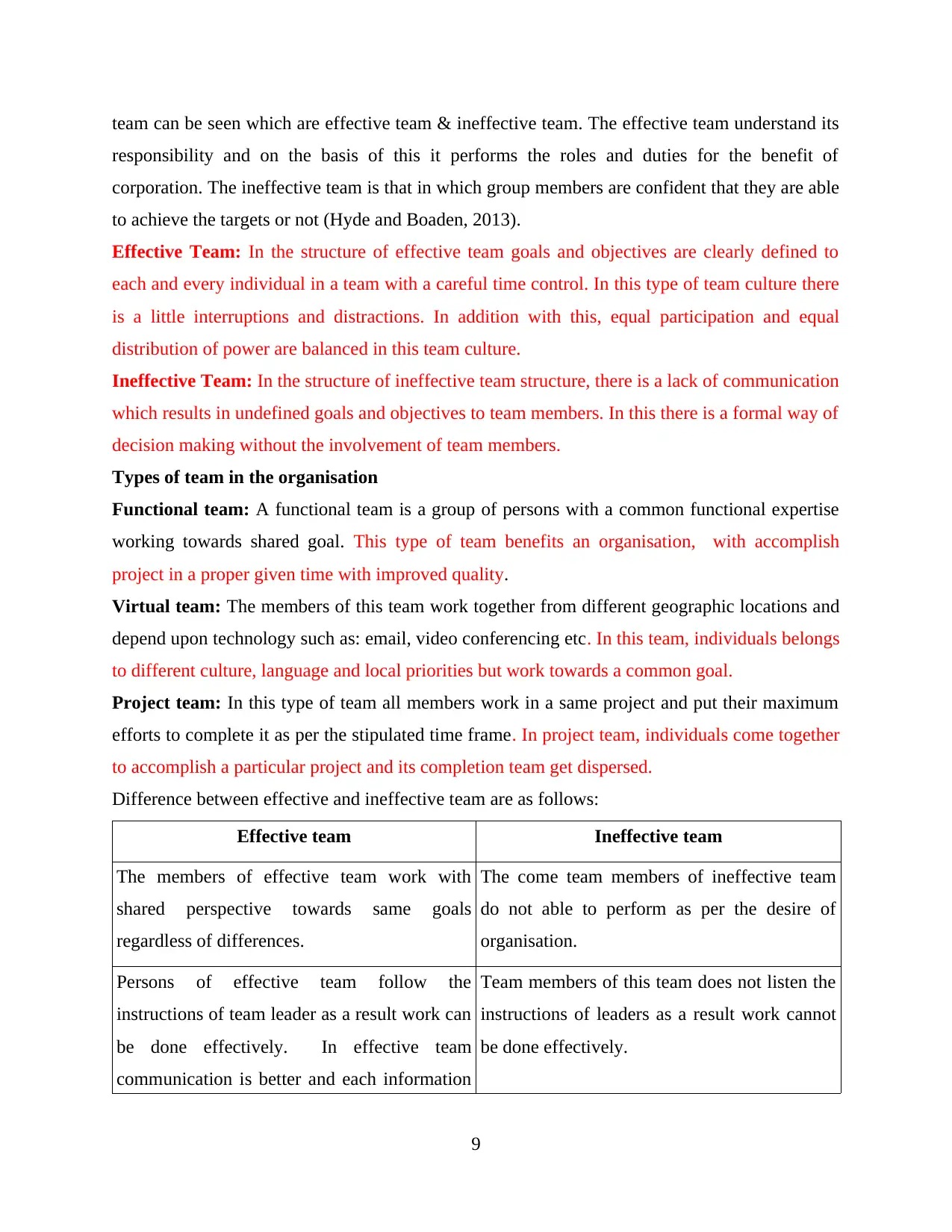
team can be seen which are effective team & ineffective team. The effective team understand its
responsibility and on the basis of this it performs the roles and duties for the benefit of
corporation. The ineffective team is that in which group members are confident that they are able
to achieve the targets or not (Hyde and Boaden, 2013).
Effective Team: In the structure of effective team goals and objectives are clearly defined to
each and every individual in a team with a careful time control. In this type of team culture there
is a little interruptions and distractions. In addition with this, equal participation and equal
distribution of power are balanced in this team culture.
Ineffective Team: In the structure of ineffective team structure, there is a lack of communication
which results in undefined goals and objectives to team members. In this there is a formal way of
decision making without the involvement of team members.
Types of team in the organisation
Functional team: A functional team is a group of persons with a common functional expertise
working towards shared goal. This type of team benefits an organisation, with accomplish
project in a proper given time with improved quality.
Virtual team: The members of this team work together from different geographic locations and
depend upon technology such as: email, video conferencing etc. In this team, individuals belongs
to different culture, language and local priorities but work towards a common goal.
Project team: In this type of team all members work in a same project and put their maximum
efforts to complete it as per the stipulated time frame. In project team, individuals come together
to accomplish a particular project and its completion team get dispersed.
Difference between effective and ineffective team are as follows:
Effective team Ineffective team
The members of effective team work with
shared perspective towards same goals
regardless of differences.
The come team members of ineffective team
do not able to perform as per the desire of
organisation.
Persons of effective team follow the
instructions of team leader as a result work can
be done effectively. In effective team
communication is better and each information
Team members of this team does not listen the
instructions of leaders as a result work cannot
be done effectively.
9
responsibility and on the basis of this it performs the roles and duties for the benefit of
corporation. The ineffective team is that in which group members are confident that they are able
to achieve the targets or not (Hyde and Boaden, 2013).
Effective Team: In the structure of effective team goals and objectives are clearly defined to
each and every individual in a team with a careful time control. In this type of team culture there
is a little interruptions and distractions. In addition with this, equal participation and equal
distribution of power are balanced in this team culture.
Ineffective Team: In the structure of ineffective team structure, there is a lack of communication
which results in undefined goals and objectives to team members. In this there is a formal way of
decision making without the involvement of team members.
Types of team in the organisation
Functional team: A functional team is a group of persons with a common functional expertise
working towards shared goal. This type of team benefits an organisation, with accomplish
project in a proper given time with improved quality.
Virtual team: The members of this team work together from different geographic locations and
depend upon technology such as: email, video conferencing etc. In this team, individuals belongs
to different culture, language and local priorities but work towards a common goal.
Project team: In this type of team all members work in a same project and put their maximum
efforts to complete it as per the stipulated time frame. In project team, individuals come together
to accomplish a particular project and its completion team get dispersed.
Difference between effective and ineffective team are as follows:
Effective team Ineffective team
The members of effective team work with
shared perspective towards same goals
regardless of differences.
The come team members of ineffective team
do not able to perform as per the desire of
organisation.
Persons of effective team follow the
instructions of team leader as a result work can
be done effectively. In effective team
communication is better and each information
Team members of this team does not listen the
instructions of leaders as a result work cannot
be done effectively.
9
⊘ This is a preview!⊘
Do you want full access?
Subscribe today to unlock all pages.

Trusted by 1+ million students worldwide
1 out of 19
Related Documents
Your All-in-One AI-Powered Toolkit for Academic Success.
+13062052269
info@desklib.com
Available 24*7 on WhatsApp / Email
![[object Object]](/_next/static/media/star-bottom.7253800d.svg)
Unlock your academic potential
Copyright © 2020–2025 A2Z Services. All Rights Reserved. Developed and managed by ZUCOL.




